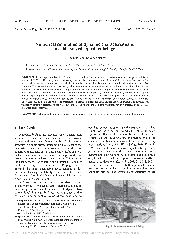摘要
In this paper, a full-scale 3-D finite element model of the Jundushan cable-stayed aqueduct bridge is established with ANSYS Code. The shell, fluid, tension-only spar and beam elements are used for modeling the aqueduct deck, filled water, cables and support towers, respectively. A multi-element cable formulation is introduced to simulate the cable vibration. The dry (without water) and wet (with water) modes of the aqueduct bridge are both extracted and investigated in detail. The dry modes of the aqueduct bridge are basically similar to those of highway cable-stayed bridges. A dry mode may correspond to two types of wet modes, which are called the in-phase (with lower frequency) and out-of-phase (with higher frequency) modes. When the water-structure system vibrates in the in-phase/out-of-phase modes, the aqueduct deck moves and water sloshes in the same/opposite phase-angle, and the sloshing water may take different surface-wave modes. The wet modes of the system reflect the properties of interaction among the deck, towers, cables and water. The in-phase wet frequency generally decreases as the water depth increases, and the out-of-phase wet frequency may increase or decrease as the water depth increases.
- 出版日期2011-12
- 单位同济大学
